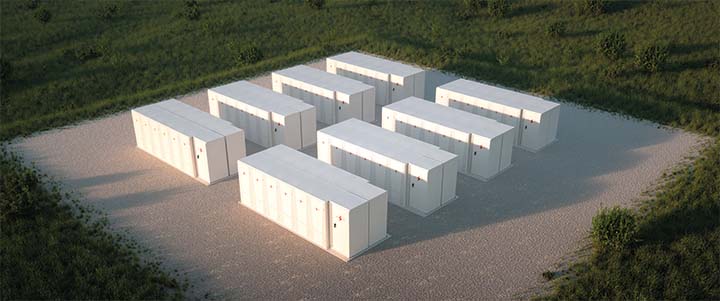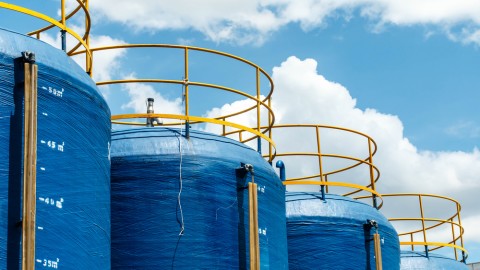Battery storage systems are vital assets for stabilising energy generation during the national energy transition, and a robust stock of storage assets might serve as the best insurance policy for any network powered by renewables.
Around the country, utility-scale batteries are gaining traction, with newly delivered assets including one of the largest batteries seen globally – the Victorian Big Battery. Indeed, the national battery sector is expected to reach new heights this year, with independent energy consultancy Rystad predicting that utility-scale battery capacity will double.
Here we offer a comprehensive assessment of the big battery projects shaping Australia’s energy storage future: from major operational batteries, to those under construction, newly approved, or ambitiously proposed.
Australia’s energy networks are evolving, and lithium-ion battery storage projects will help ensure our national energy transition is both manageable and secure. The costs associated with grid-scale battery storage technologies have significantly decreased over the last decade, while battery storage capabilities continue to grow rapidly, resulting in a much improved economic case for large-scale battery projects.
As a result, governments and private companies are investing in an ever-increasing number of big batteries to expand network storage capabilities. Large-scale, grid-connected battery systems are expected to play an important role in Australia’s energy future, with a growing number of large storage projects planned or underway, acting to both smoothen renewable generation and offer network contingency.
Why we need batteries: matching the rise of renewables
The Australian Energy Market Operator (AEMO) has predicted that 63 per cent of coal-fired generation will retire by 2040, making way for 26 50GW of renewable energy generation across wind and solar (2020 Integrated System Plan). But this rise of renewables must be matched by up to 19GW of ‘firming’ generation assets, such as battery storage and pumped hydro, that are dedicated to supplying energy during times of poor renewable generation.
Integrated into the National Electricity Market (NEM), big batteries will help stabilise networks and pave the way for increased renewable generation, allowing states and territories to make sustainable and safe progress on renewable energy targets.
Large-scale energy storage, such as Battery Energy Storage System (BESS), offers a range of important benefits to electricity grids, from responding to fluctuations in renewable energy generation to managing frequency disruptions.
Batteries can be used for energy market participation, load shifting, and providing various market and non-market ancillary services to the NEM. As a result, batteries can help mitigate costs and suspend the need for additional generation infrastructure, or network upgrades to meet peak demand.Further, battery peakers can ramp up quickly, have near zero start-up time and provide a strong frequency response.
Now showing: operational big battery projects
Victorian Big Battery (300MW/450MWh), VIC
Launched in December 2021, the Victorian Big Battery is both the largest operational battery in Australia and one of the world’s largest batteries to date. The 300MW/450MWh BESS, built and operated by Neoen, is located in Geelong.
The battery will be instrumental in helping Victoria reach its target of 50 per cent renewable energy generation by 2030. The Federal-owned Clean Energy Finance Corporation (CEFC) has provided $160 million towards its construction.
The Victorian Government will pay $84.8 million over 11 years for the services provided by the BESS, which should alleviate unscheduled load shedding over the peak summer months. The project experienced a setback in July 2021, when a fire occurred at two of the Tesla Megapack BESS units during testing. Works resumed with the approval of the safety regulator after measures were put in place to prevent recurrence.
Hornsdale Power Reserve (150MW/193.5MWh), SA
With a capacity of 150MW/194MWh, Hornsdale Power Reserve is currently the second largest operational battery in Australia. The battery is owned by Neoen and co-located with the Hornsdale Wind Farm in mid-north South Australia.
When the original $172 million construction project was completed in 2017, it was the largest lithium-ion battery in the world at 100MW/129MWh. In 2020, an $82 million expansion project was completed, increasing the storage capacity by 50MW/64.5MWh to a total of 150MW/193.5MWh. The installation is based on Tesla battery technology.
Lake Bonney BESS (25MW/52MWh), SA
The Lake Bonney Battery Energy Storage System, located with the Lake Bonney Wind Farm near Millicent in South Australia, has a capacity of 25MW/52MWh. This Tesla-based lithium-ion BESS is owned by Infigen and was energised in 2019. According to ARENA, which co-funded the project, the Final construction cost totalled around $41.6 million.
Gannawarra Energy Storage System (25MW/50MWh), VIC
The Gannawarra Energy Storage System (GESS) is a 25MW/50MWh grid-scale lithium-ion battery located with the Gannawarra Solar Farm in north-western Victoria. The $41.19 million project was undertaken by Edify in a consortium with Wirsol Energy, using Tesla Powerpack technology, and was completed in 2018. The GESS is operated by EnergyAustralia, under agreement with the joint owners Edify and Wirsol.
Ballarat Energy Storage System (30MW/30MWh), VIC
The Ballarat Energy Storage System (BESS) has a capacity of 30MW/30MWh and utilises Fluence lithium-ion battery technology. The BESS is a standalone system, located at the AusNet Services Ballarat Terminal Station in Warrenheip, Ballarat. It is owned by Ausnet Services, and operated by EnergyAustralia.
The construction project was undertaken by a consortium comprising Downer Spotless, AusNet Services, EnergyAustralia and Fluence, and the BESS was integrated into the Victorian grid in 2018.
Bulgana Green Power Hub Battery Storage (20MW/34MWh), VIC
This 20MW/34MWh Tesla-based lithium-ion battery is par of the Bulgana Green Power Hub in the Wimmera region of central-western Victoria, along with a 194MW wind farm. The hub is owned by Neoen, which undertook a $350 million project to construct the battery and wind farm. After delays in commissioning, the battery was switched on in 2021.
Dalrymple BESS (30MW/8MWh), SA
The 30MW/8MWh Dalrymple Battery Energy Storage System is located at ElectraNet’s Dalrymple substation on the Yorke Peninsula in South Australia. The $30 million project was completed in 2018 and was the first BESS in the National Electricity Market (NEM) to provide both regulated network reliability and security services alongside competitive market services.
The Dalrymple BESS is owned by ElectraNet and operated by AGL. This standalone BESS uses Samsung lithium-ion battery technology. In 2021, ElectraNet returned the $12 million grant the company received to construct the BESS to the Australian Renewable Energy Agency (ARENA), due to the project’s financial success.
Newman Battery Storage (35MW/11MWh), WA
The Newman BESS operates on an islanded high-voltage grid supplying power to major mining operations in the Pilbara region of WA. It is owned by Alinta Energy and located adjacent to the company’s gas-fired Newman Power Station. This 35MW/11MWh battery system uses Kokam technology. Its construction cost was around $45 million and it was completed in 2018.
Agnew Gold Mine BESS (13MW/4MWh), WA
The Agnew Gold Mine BESS is another battery system operating on a private grid in Western Australia. The BESS is part of the hybrid gas and renewable energy microgrid powering operations at the remote Agnew Gold Mine. The $111.6 million microgrid project was completed in 2020 and uses Saft lithium-ion batteries.
Coming soon: big battery projects under construction
Wandoan South BESS (100MW/150MWh), QLD The 100MW/150MWh Wandoan South Battery Energy Storage System (BESS) is being constructed by Vena Energy in the Darling Downs region of Queensland. The $120 million construction project is nearing completion and, once operational, the BESS will be contracted to AGL.
The BESS uses lithium-ion battery technology, operated by a Doosan control and monitoring system. When connected to Powerlink’s Wandoan South Substation, it will be Western Australia’s first state-grid-connected big battery.
Wallgrove Grid Battery/Western Sydney BESS (50MW/75MWh), NSW
Construction on Transgrid’s 50MW/75MWh Wallgrove Grid Battery began in early 2021, at the Wallgrove substation in Western Sydney.
When commissioned, the Tesla Megapack lithium-ion battery system will be operated by Infigen, providing synthetic inertia and fast frequency response services to stabilise the grid.The project is expected to cost around $61.9 million in total.
Tom Price Battery (45MW/12MWh), WA
The Tom Price Battery is under construction by Rio Tinto in the Pilbara region of Western Australia. The lithium-ion battery system will have a capacity of 45MW/12MWh and power Rio Tinto’s iron ore mining operations. When complete, the Tom Price Battery will be the largest battery connected to a private grid (as opposed to an interconnected national grid, such as the Australian NEM) in the world. The system is employing Hitachi ABB inverters and Kokam batteries.
Lincoln Gap BESS (10MW/10MWh), SA
The 10MW/10MWh Lincoln Gap BESS is located at the Lincoln Gap Wind Farm in South Australia. The BESS is owned by Nexif Energy and utilises LG Chem lithium-ion battery technology, supplied by Fluence. The battery was installed as part of the ongoing three-stage $770 million Lincoln Gap Wind Farm project.
Construction of the battery is complete, but commissioning has been subject to significant delays, due to a supplier change resulting in regulatory issues. The second stage of the project is currently underway, and the battery capacity is likely to be expanded in the future.
Wooreen Energy Storage System (350MW/1400MWh), VIC
Co-located with EnergyAustralia’s Jeeralang gas-fired power station, the Wooreen Energy Storage System will be Australia’s first four-hour utility-scale battery of 350MW capacity. It will provide cover for more than 230,000 Victorian households for four hours before needing to be recharged. EnergyAustralia is currently seeking partners to help in the delivery of this project, which is scheduled for completion by 2026.
Lock it in: approved big battery projects
In addition to those already under construction, a multitude of big battery projects are soon to begin or have been confirmed. With the market for grid-scale battery services expanding rapidly, an ever-increasing number of projects are being announced or progressing through various stages of planning. According to Rystad data, as of December 2021, around 28GW of utility-scale batteries were in the pipeline across Australia. Here we look at a selection of the largest confirmed battery projects so far.
Kurri Kurri Battery (1.2GW), NSW
In 2021, CEP Energy unveiled plans for a 1.2GW (1,200MW) battery energy system at Kurri Kurri. CEP Energy has secured a lease on the site of the proposed project, which is approved for power generation. Construction is expected to begin this year, so the BESS can start operating in 2023.
Goyder Renewables Hub BESS (up to 900MW/1.8GWh), SA
Neoen has secured approval to build a battery of up to 900MW/1800MWh in Goyder South, as part of the $3 billion Goyder South Renewables Zone project. The zone will also feature up to 1.2GW of wind energy, and 600MW of solar power generation. Work has already begun on the first stage of the project, which involves constructing a 412MW wind farm at the site.
Loy Yang Battery (200MW/800MWh), VIC
AGL has received planning approval for a 200MW/800MWh battery at the Loy Yang Power Station in Victoria’s Latrobe Valley. This BESS is part of the company’s planned national rollout of 850MW of grid-scale batteries.
Eraring Battery (700MW/2.8GWh), NSW
Origin is progressing plans for a 700MW/2800MWh gridscale battery at Eraring Power Station in New South Wales. The company has lodged a connection inquiry with Transgrid to connect the battery to the national grid via the Eraring substation. The full capacity of the BESS will be deployed over three stages, with the first expected to be reached by the end of 2022.
Gould Creek Battery (225MW/450MWh), SA
Maoneng has received development approval and is undertaking procurement for a 225MW/450MWh BESS adjacent to the Para transmission substation in Playford, South Australia. Construction is planned to begin in late 2022, with completion expected before the end of 2023.
Sunraysia Emporium BESS (100MW/200MWh), NSW
Maoneng has announced a 100MW/200MWh battery system, called Sunraysia Emporium, near Balranald in New South Wales. The battery is expected to be completed in 2022/2023.
Bouldercombe Battery (50MW/100MWh), QLD
Genex is progressing plans to build a 50MW/100MWh battery on land adjacent to Powerlink’s Bouldercombe substation in Queensland.
The battery will comprise forty Tesla Megapacks and is expected to be operational by the end of 2023.
Big Canberra Battery Project (250MW), ACT
The ACT Government has announced plans to build 250MW of battery storage capacity and is in the process of shortlisting proposals. The total storage capacity will be made up of one or more batteries spread across the territory. Dream big: the latest proposed battery projects In recent times, dozens of new battery storage projects have been proposed.
These include multiple battery systems with massive storage capacities of over a gigawatt. Those that follow are just a few of the biggest proposed big batteries to date.
Australia-Asia PowerLink Battery (36–42 GWh), NT
In the Northern Territory, Sun Cable intends to build a 36–42GWh battery. The Australia-Asia PowerLink would be the world’s largest battery storage facility and solar farm. It is intended to supply Darwin, Singapore and Asian Markets. The project is expected to cost around $30 billion to construct, and to provide around $2 billion of energy exports per year. The first supply of electricity to Darwin is forecast for 2026, the first supply to Singapore in 2027, and full capacity by the end of 2028.
Photon Solar and Storage Battery (3.6GWh), SA
Dutch-based solar developer Photon Energy proposes to construct a 300MW solar generation facility, along with 3.6GWh of battery storage, in South Australia. Photon has secured land for the project and is progressing plans.
Melton Renewable Energy Hub BESS (600MW/2.4GWh), VIC
Syncline Energy has released plans to build a 600MW/2400MWh BESS in Victoria. According to the proposal, the Melton Renewable Energy Hub will connect to the grid via AusNet’s Sydenham terminal station.
The big build continues
Among the many other large grid-scale battery projects proposed across Australia are the 500MW/1GWh Great Western and Wallerawang nine batteries, and the 700MW/1.4GWh Waratah Super Battery, all in New South Wales; the 203MW/812MWh La Trobe Valley BESS in Victoria; and the Robertstown Solar Battery (250MW/1GWh)
in South Australia.
The rapid expansion of the energy storage arena, and a continued drive to decarbonise the economy and reach netzero emissions, means one thing is for sure about Australia’s big battery future: more is yet to come. Australia’s national energy sector will continue to benefit from ambitious storage projects like the Victorian Big Battery – a critical new asset that will directly help Victoria reach the important target of 50 per cent renewable energy generation by 2030.
















